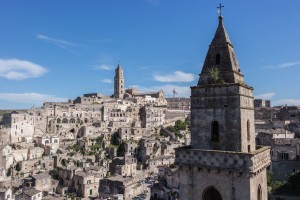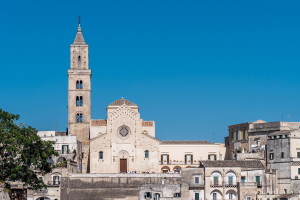There are old Italian cities uniting hundreds, even thousands of years’ worth of history in one place. And there’s the city of arts Matera, one of the oldest cities in the world. The capital of the eponymous province in the Southern Italian region of Basilicata was populated as early as the Neolithic Age. Cave dwellings from that very era still form the core of the historic city and are one of the country’s most fascinating UNESCO World Heritage Site. But that’s far from everything you get to experience when visiting Matera.
A hint of Matera’s history
Experts continue to debate when the region was first populated. Current consensus hints at the Palaeolithic, somewhere around the 10th millennium BC, although the famous cave dwellings themselves might’ve only been created during the Neolithic. The Roman city Matera, however, was founded as Matheola by the Roman Consul Lucius Caecilius in 251 BC. Matera had many different rulers after the fall of the Western Roman Empire, was desolated by the Saracens in 938 and experienced a lasting heyday the following century when the Normans took over. Changing ruling houses and dynasties, earthquake and pestilences continued the tumultuous history until the unification with the Kingdom of Italy.
Sassi di Matera

©Bigstock.com/rosariomanzo
People still lived in caves without running water or electricity during the mid-20th century, something that was seen as a cultural disgrace in Italy, especially after a severe outbreak of malaria. This expedited the relocation of the cave inhabitants to newly built apartment buildings during the 1950s and 1960s. However, it would take until the late 1980s for the renovation of the Sassi, the presumably Neolithic cave dwellings, to finally be put into motion. The Sassi di Matera have been a UNESCO World Heritage Site since 1993 and are supposed to become actual accommodations again with the aid of grants; at least that’s the ambitious plan of the city.
Matera lent itself to the construction of these kinds of dwellings due to its location on a large, exposed tuff rock. The material was easy to transport and process, hollowing and sealing was simple even in prehistoric times. The Sassi di Matera gained complex expansions in later centuries, such as several different rooms or fountain and irrigation systems. Caves were even built on top of one another later on to make even more space available. You can visit the Sassi during guided tours, and that’s an absolute must. While you’re at it, why not check out the Park of Rupestrian Churches? The archaeological and historical nature park covers a territory of more than 8,000 hectares expanding into the adjacent village Montescaglioso and is dedicated to old houses of prayers in stone.
Castello Tramontano
There’s no doubt that the Sassi alone are more than reason enough to visit Matera. However, the city in the Basilicata region has so much more to offer. The fortress Castello Tramontano on the Lapillo hill overlooks the historic core. Its origins date back to Norman times. The former residence with its eight towers on a square layout was supposed to protect against potential attacks yet was torn down to give way for a more suitable fortress. Construction of the Aragonese-style structure only began in 1501.
Originally, a bridge connect both towers; a battlement parapet to Castiglione Normanno, however, was never realised. Additional towers and elements were planned as well but Castello Tramontano remained unfinished. The rather imposing structure with its central keep, old tuff stone walls, large moats and ample park has been in restoration since 2008 and continues to regain its old splendour step by step. Sadly, you can’t check out the fortress at the moment, but the hike there is more than spectacular.
Other sights in Matera

©Bigstock.com/DinoPh
Lots of tuff and old rock accompany your tour of Matera. However, the city in the south has far more in store. The following three highlights are must-see!
- Cathedral of Matera: Construction of this church on the highest point of the city between two Sassi structures began in 1230. The former site of the Benedictine monastery saw the creation of a large cathedral for the newly established archdiocese over the following four decades. The outside with the large rose window and the pillars resting on large atlases remained almost the same. In turn, the interior was redecorated from 1627 onward gaining ostentatious sculptures, frescoes, ceiling paintings and altarpieces.
- San Pietro Caveoso: There are actually plenty of churches in Matera. San Pietro Caveoso is one of the city’s gems. Situated amidst the Sassi, the baroque façade with its three statues alone is quite the sight. Various paintings and an astounding 13th century baptismal font make it worth sneaking a peek inside.
- Palazzo dell’Annunziata: With a city of such long history this palace can certainly be seen as a modern piece since construction “only” started in 1735. Being a symbol of wealth and abundance, it originally displaced an important monastery for representative reasons and feels alien. The palace currently houses Matera’s public library.
Culture and cuisine
A few places you’ll come across while walking through Matera might seem familiar. The Sassi have been used as the cinematic setting of ancient Jerusalem for decades. Parts of Mel Gibson’s “The Passion of the Christ”, Pasolini’s “The Gospel According to St. Matthew”, the new 2016 version of “Ben-Hur”, and Daniel Craig’s final Bond movie “No Time to Die” were shot here. The unique location has also attracted artists from Metallica to Robin Schulz to film music videos.
And then, there’s Matera’s excellent cuisine that will most certainly spoil your palate. Here are some of the delights you’ll sample in the city’s restaurants and cafés:
- Crapiata, a soup of Roman origin that used to be predominantly consumed by peasants
- Pasta with peperoni cruschi, a dry and sweet kind of pepper, and added breadcrumbs
- Orecchiette alla materana with lamb, mozzarella and pecorino cheese
- Crumbly Strazzate cookies with almonds and coffee
- DOC wine from the Matera region in eight different varieties from red to white to rosé
Welcome to the Neolithic . . . and to modern times because the city of arts Matera has it all and so much more to offer. The Sassi are the definite highlight without doubt, but the manner in which contemporary elements and cinematic masterpieces have been incorporated into the historic setting will wow you over and over again. Time to travel down south!